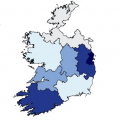
Involuntary Part-time Work
28 Jun 2017Key Point
Unemployment – which has fallen from 15.2% in January 2012 (327,900) to 6.4% in May 2017 (140,700) – still presents a significant challenge. Approximately 92,000 part-time workers would prefer to work more than they currently do.
Full-time and Part-time Employment
In Q1 2017, there were over two million people in employment. The numbers in full-time and part-time employment from 2012 to 2017 (in Q1 of each year) as reported in the QNHS1 are shown in table 1.
Table 1 – Employment numbers (Thousands), Q1 2012 – 2017
(Source: CSO (2017), QNHS)
Table 1 shows that full-time employment has grown by 15.0% (209,700) between 2012 and 2017. Part-time employment increased by 2.4% (10,400). Total employment has increased by 220,100 (12.1%). Over three-quarters of all jobs are full-time. The change in the proportion of full-time and part-time employment between 2007 and 2017 is shown below.
Figure 1 – Full-time & Part-time Employment Shares

(Source: CSO (2017), QNHS Q1 2017)
The share of those employed part-time peaked in 2013 at approximately one-in-four (24.6%) and has reduced to 21.5% as of Q1 2017. The full-time employment share has increased from its trough of 75.4% in 2013 to reach 78.5% in 2017, although this is below its peak of 82.6% found in 2007.
Reasons for Part-time Employment
Figure 2 shows the percentage share of reasons given for part-time employment in Q1 2017.
Figure 2

(Source: QNHS Q1 2017, Employment Series)
Figure 2 highlights that 27% of part-time workers could not find a full-time job2 . One-in-four part-time workers (25%) had personal or family reasons for working part-time. Approximately one-in-five part-time workers (18%) were looking after children or incapacitated adults. Only two per cent attributed their part-time work with illness or disability. The proportion of PT workers stating that they could not find a full-time job was 10% in 2007 and 39% in 2014. Despite this almost quadruple increase, the proportion citing this reason for PT work has been decreasing each year since 2014.
Involuntary Part-time employment
There were 440,600 persons in part-time employment in Q1 2017. Of these, 92,800, or more than one-fifth (21.1%) of all part-time workers, were underemployed (i.e. involuntary part-time workers).
Has the Share of Involuntary Part-time workers increased or decreased?
Table 2 shows the number of involuntary part-time workers in quarter 1 of each year from 2009 to 2017.
Table 2 – Part-time Employment, 2009 – 2017
(Source: CSO (2017), QNHS Q1 2017)
As a share of part-time employment, the number of involuntary PT workers has declined to 21.1%, which is the lowest share found over the period shown in table 2. Table 2 shows that involuntary PT workers as a share of total employment have declined to 4.5%, the lowest share in eight years.
Women comprise 70% (307,900) of the 440,600 people employed part-time in Q1 2017. They also account for the majority (55% or 51,000) of those working part-time who are underemployed. In addition, as shown in figure 2 above, 18.5% of those employed part-time attribute it to looking after children or incapacitated adults. The European Commission3 in its recent assessment of Ireland’s progress continued to highlight the impact of childcare4 –
“The availability and cost of quality full-time childcare present barriers to female labour market participation and hinder efforts to reduce child poverty”.
Conclusion
Approximately 4.5 per cent of those in employment (92,800) were working in involuntary part-time positions in Q1 2017. This is equivalent to one-fifth of PT workers. This highlights the need to continue focus on jobs to meet this demand.
_____________________________
Notes:
1 Quarterly National Household Survey (QNHS)
2 This question is directed at those who have changed job since the previous quarter and are working part-time instead of full-time. It also covers cases where it is the person’s first interview. This is a different measure to underemployment.
3 European Commission (2017) Recommendation for a Council Recommendation on the 2017 National Reform Programme of Ireland and delivering a Council opinion on the 2017 Stability Programme of Ireland
4 Childcare costs in Ireland are the second highest in the OECD for couples and the highest in the OECD for lone parents. The Single Affordable Childcare Scheme, due to commence in September 2017, aims to make childcare more affordable. Families will obtain a childcare subsidy based on their net income.








